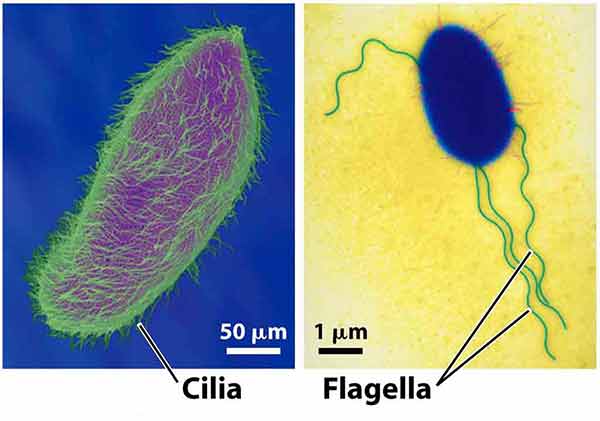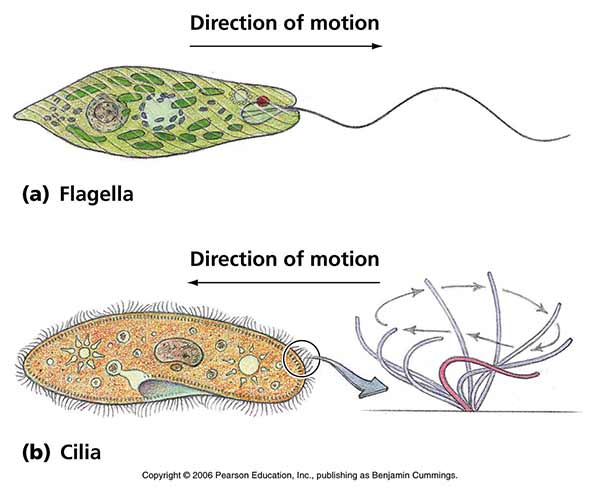Flagella are the complex filamentous cytoplasmic structure protruding through cell wall. These are unbranched, long, thread like structures, mostly composed of the protein flagellin, intricately embedded in the cell envelope.
Cilia are slender, microscopic, hair-like structures or organelles that extend from the surface of nearly all mammalian cells (multiple or single).
| S.N. | Characteristics | Cilia | Flagella |
|---|---|---|---|
| 1 | Definition | Cilia are short, hair like appendages extending from the surface of a living cell. | Flagella are long, threadlike appendages on the surface of a living cell. |
| 2 | Number | Numerous | Less in Number |
| 3 | Length | Short and hair like organelle (5-10µ) | Long wipe like organelle (150µ) |
| 4 | Occurrence | Occurs throughout the cell surface. | Presence at one end or two ends or all over the surface. |
| 5 | Cross section | Nexin arm present. | Nexin arm absent |
| 6 | Density | Many (hundreds) per cell | Few (less than 10) per cell |
| 7 | Beating | Cilia beat in a coordinated rhythm either simultaneously (synchronous) or one after the other (metachronic). | They beat independent of each other. |
| 8 | Motion | Rotational, like a motor, very fast moving | Wave-like, undulating, sinusoidal, slow movement compared to cilia |
| 9 | Found in | Eukaryotic cells | Eukaryotic and prokaryotic cells |
| 10 | Energy Production | Cilia use ‘kinesin’ which has an ATPase activity that produces energy to perform the movement. | Flagella are powered by the proton-motive force by the plasma membrane. |
| 11 | Functions | Helps in locomotion, feeding circulation, aeration, etc. | Help mainly in locomotion only. |
| 12 | Examples | Cilia present in Paramecium | Flagella present in Salmonella |
Similar Posts:
- Flagella – Introduction, Types, Examples, Parts, Functions and Flagella Staining- Principle, Procedure and Interpretation
- Different Size, Shape and Arrangement of Bacterial Cells
- Cryptococcus Neoformans – Habitat, Morphology, Epidemiology, Virulence Factors, Treatment + More
- Techniques of Virus Cultivation



Man, you’re confusing people. You should start with the distinction between prokaryotic flagella (which are totally different in structure and mechanism of beating!) and eukaryotic cilia and flagella. Then you could say about differences between eukaryotic cilia and flagella but actually the current consensus in the field is that these 2 organelles were historically called differently because of some morphological features but they are very close to each other from evolutionary perspective and hence represent just 2 variants of the same structure. Have a look at any recent review about cilia and flagella and you will know what I’m talking about. Cheers!
I want a answer on ” why some organisms have cilia and others have flagella “
It’s called difference in course of evolution….